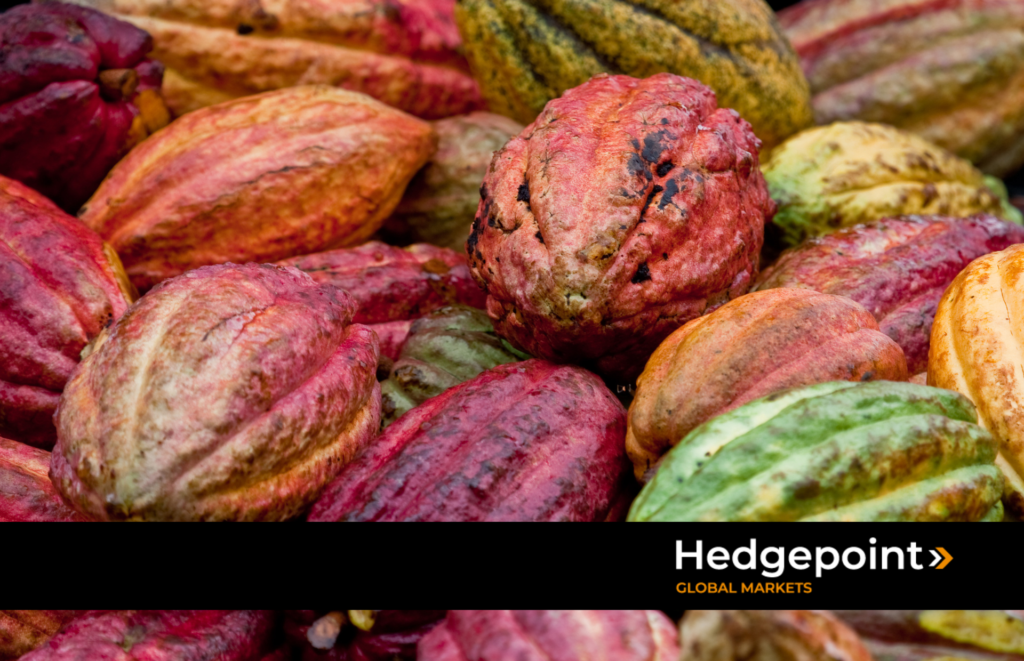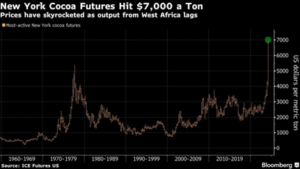
On World Chocolate Day, celebrated on July 7, we seek to understand how the cocoa production chain operates in the balance between supply and demand and ho

On World Chocolate Day, celebrated on July 7, we seek to understand how the cocoa production chain operates in the balance between supply and demand and how this is affecting market volatility.
Just to give you an idea, futures contracts for the commodity reached a new intraday record and exceeded US$ 11,000 in New York for the first time in April 2024. And the price of cocoa continues to be volatile on the international market.
To begin to understand the market, we explain how cocoa production works around the world:
Before it reaches the consumer as chocolate and other products, there is a whole process that begins with the cacao tree, the perennial plant from which the cacao fruit is extracted. There are basically three cultivated varieties:
There are basically seven stages in the cocoa production chain. Below, we explain each of them.
The production unit (UP) or rural property begins to grow cocoa. This stage requires preparing the soil, which must be rich in organic matter and well-drained.
Cocoa trees are planted in suitably shady conditions, usually under taller trees to protect them from direct sunlight. During cultivation, farmers monitor the trees to ensure that they receive enough water and are free from pests and diseases.
Cocoa is harvested by hand for 3-4 weeks, after which the beans germinate and regular picking is necessary. Farmers open the fruit and remove the wet beans within a week to 10 days of harvesting.
After harvesting, the cocoa beans are split open. The seeds, known as cocoa beans, are removed and placed in boxes or mounds to ferment. This process can last from a few days to a week, depending on local conditions.
Fermentation creates the characteristic flavors of cocoa by removing undesirable substances and developing compounds that contribute to the taste of chocolate.
After fermentation, the cocoa beans are spread out in the sun to dry. This process can take several days and is essential to reduce the moisture content of the beans, which helps prevent mold during storage.
The cocoa beans are turned regularly to ensure even drying and prevent mold from forming. When the beans have reached the ideal moisture content, they are packaged and sent for further processing, such as roasting and grinding, to produce chocolate.
The next step in the process can vary. Farmers have several options: they can transport, classify and export their grain directly; sell to an intermediary; or join a cooperative that handles sales to the exporter. Regardless of the method chosen, the grain is inspected, sorted and sent to a warehouse near the port.
Once sorted, the grains are prepared for shipment on cargo ships. They can be shipped in jute bags or in bulk. Bulk transportation can be done in containers or without packaging.
Cocoa beans are roasted to reduce their water content and develop aromas and flavors. This can be done before hulling the whole beans or after they have been hulled. After roasting and hulling, the beans are ground at high temperatures to form a fine cocoa liquor, which can be used directly as a culinary ingredient. The cocoa liquor can be pressed through a fine sieve, separating it into solid material (cocoa cake) and a purer liquid/cream (cocoa butter). The cake can be broken into smaller pieces and welded, or pulverized into a powder with varying fat content.
There are specific factors that justify the volatility currently affecting the cocoa market, as they have a direct impact on West Africa. This is where the world’s two largest producers are concentrated: Ivory Coast and Ghana.
Below, we explain each of the aspects that have influenced production in this region.
Cocoa is climate-dependent because weather conditions directly affect its growth and development. Consistent and moderate temperatures, combined with adequate humidity, are essential for the flowering, fruiting and ripening of cocoa fruits. This crop is particularly vulnerable to water scarcity, requiring between 1,500 mm and 2,000 mm of rain annually for optimal development. Dry periods, with less than 100 mm of rain for more than three months, can significantly reduce productivity. During the fruit bud development phase, especially in the middle of the harvest, factors such as the Harmattan and the dry season play a crucial role.
In addition, regular rainfall is crucial to ensuring an adequate supply of water for cocoa trees. This promotes healthy growth and fruit production.
The harmattan, a phenomenon of dry winds and dust that rises from the Sahara, has made the climate drier in Ivory Coast and Ghana. El Niño also changed temperatures and reduced rainfall in some regions, which reduced productivity in the last cycle.
Cocoa plantations can suffer from the presence of agricultural pests such as:
Today, however, the pest that most affects cocoa is the swollen bud virus. This is a serious disease that interferes with cocoa plantations. It causes swelling in the buds and deformities in the leaves, with significant damage to production.
Ghana is expected to produce 40% below the target for the season. The swollen bud virus is contributing to this, along with the late application of pesticides and fungicides to protect the cocoa trees.
In order to reduce costs, the Ghanaian government has gradually decreased the distribution of cocoa seedlings and pesticides to almost a million farmers. Instead, the government paid farmers a higher price for cocoa and let them buy the equipment and services. However, many farmers pocketed the extra money from the government.
When the government found out, it went back to delivering the chemicals directly. But it was too late for the crop to grow.
Demand for cocoa remains high, despite record prices. The ICCO (International Cocoa Organization) predicts that consumption will exceed production by 38,000 tons of cocoa beans by 2024.
The main explanations for this resilience lie in increased demand from emerging markets in Asia and also in changing consumer habits. The population is not giving up small luxuries such as chocolate, a trend that began during the COVID-19 pandemic.
A black swan is any unpredictable event that has a major impact on the entire economy. In other words, events that are out of the ordinary and have global repercussions.
The philosopher Nassim Taleb introduced this concept and determined a classification for events that considerably affect the financial market. The logic behind the study is that we live in an unstable world. In this sense, it is essential to prepare to manage risks.
And that’s what happened in the cocoa market in 2024. Due to the problems in African plantations, there was what we might call a black swan. After all, the impacts were significant and intense in relation to the commodity’s prices, which skyrocketed all over the planet and continue to trend upwards.
Cocoa futures in New York reach US$7,000 a tonne


Source: Bloomberg
Read also: General outlook for agricultural and energy commodities in 2024
The cocoa market suffered a so-called black swan event. In other words, production of the commodity was impacted, which continues to affect the entire globe.
In this sense, market participants must adopt instruments to protect themselves from volatility. After all, risks will always exist. Hedgepoint provides commodity hedging products, such as the use of derivatives, to fix the price of cocoa in relation to buying and selling in the future.

Rua Funchal, 418, 18º andar - Vila Olímpia São Paulo, SP, Brasil
Contato
(00) 99999-8888 example@mail.com
Section
Home
O que Fazemos
Mercado
Quem Somos
HUB
Blog
Esta página foi preparada pela Hedgepoint Schweiz AG e suas afiliadas (“Hedgepoint”) exclusivamente para fins informativos e instrutivos, sem o objetivo de estabelecer obrigações ou compromissos com terceiros, nem de promover uma oferta ou solicitação de oferta de venda ou compra de quaisquer valores mobiliários, commodity interests ou produtos de investimento.
A Hedgepoint e suas associadas renunciam expressamente a qualquer uso das informações contidas neste documento que direta ou indiretamente resulte em danos ou prejuízos de qualquer natureza. As informações são obtidas de fontes que acreditamos serem confiáveis, mas não garantimos a atualidade ou precisão dessas informações.
O trading de commodity interests, como futuros, opções e swaps, envolve um risco substancial de perda e pode não ser adequado para todos os investidores. Você deve considerar cuidadosamente se esse tipo de negociação é adequado para você, levando em conta sua situação financeira. O desempenho passado não é necessariamente indicativo de resultados futuros. Os clientes devem confiar em seu próprio julgamento independente e/ou consultores antes de realizar qualquer transação.
A Hedgepoint não fornece consultoria jurídica, tributária ou contábil, sendo de sua responsabilidade buscar essas orientações separadamente.
A Hedgepoint Schweiz AG está organizada, constituída e existente sob as leis da Suíça, é afiliada à ARIF, a Associação Romande des Intermédiaires Financiers, que é uma Organização de Autorregulação autorizada pela FINMA. A Hedgepoint Commodities LLC está organizada, constituída e existente sob as leis dos Estados Unidos, sendo autorizada e regulada pela Commodity Futures Trading Commission (CFTC) e é membro da National Futures Association (NFA), atuando como Introducing Broker e Commodity Trading Advisor. A Hedgepoint Global Markets Limited é regulada pela Dubai Financial Services Authority. O conteúdo é direcionado a Clientes Profissionais e não a Clientes de Varejo. A Hedgepoint Global Markets PTE. Ltd está organizada, constituída e existente sob as leis de Singapura, isenta de obter uma licença de serviços financeiros conforme o Segundo Anexo do Securities and Futures (Licensing and Conduct of Business) Act, pela Monetary Authority of Singapore (MAS). A Hedgepoint Global Markets DTVM Ltda. é autorizada e regulada no Brasil pelo Banco Central do Brasil (BCB) e pela Comissão de Valores Mobiliários (CVM). A Hedgepoint Serviços Ltda. está organizada, constituída e existente sob as leis do Brasil. A Hedgepoint Global Markets S.A. está organizada, constituída e existente sob as leis do Uruguai.
Em caso de dúvidas não resolvidas no primeiro contato com o atendimento ao cliente (client.services@hedgepointglobal.com), entre em contato com o canal de ouvidoria interna (ombudsman@hedgepointglobal.com – global ou ouvidoria@hedgepointglobal.com – apenas Brasil) ou ligue para 0800-8788408 (apenas Brasil).
Integridade, ética e transparência são valores que guiam nossa cultura. Para fortalecer ainda mais nossas práticas, a Hedgepoint possui um canal de denúncias para colaboradores e terceiros via e-mail ethicline@hedgepointglobal.com ou pelo formulário Ethic Line – Hedgepoint Global Markets.
Nota de segurança: Todos os contatos com clientes e parceiros são realizados exclusivamente por meio do nosso domínio @hedgepointglobal.com. Não aceite informações, boletos, extratos ou solicitações de outros domínios e preste atenção especial a variações em letras ou grafias, pois podem indicar uma situação fraudulenta.
“Hedgepoint” e o logotipo “Hedgepoint” são marcas de uso exclusivo da Hedgepoint e/ou de suas afiliadas. O uso ou reprodução é proibido, a menos que expressamente autorizado pela HedgePoint.
Além disso, o uso de outras marcas neste documento foi autorizado apenas para fins de identificação. Isso, portanto, não implica quaisquer direitos da HedgePoint sobre essas marcas ou implica endosso, associação ou aprovação pelos proprietários dessas marcas com a Hedgepoint ou suas afiliadas.
aA Hedgepoint Global Markets é correspondente cambial do Ebury Banco de Câmbio, de acordo com a resolução CMN Nº 4.935, DE 29 DE JULHO DE 2021, Artigo 14 do Banco Central do Brasil (BACEN).
Para mais informações sobre nosso parceiro, serviços disponíveis, atendimento e ouvidoria, acesse o link a seguir: https://br.ebury.com/